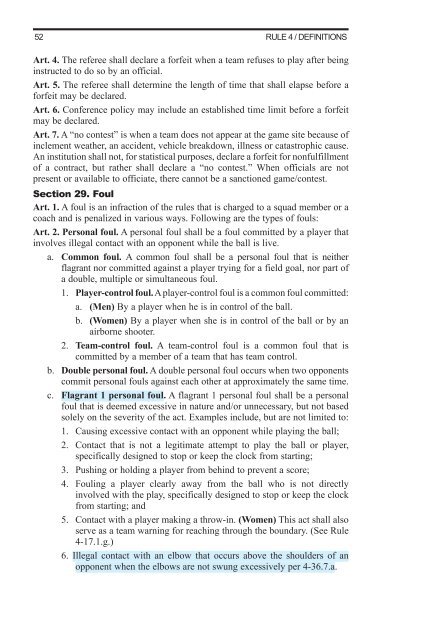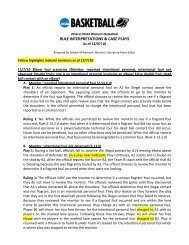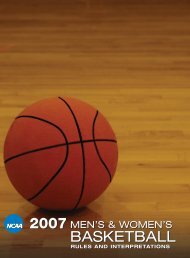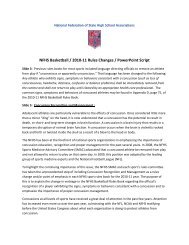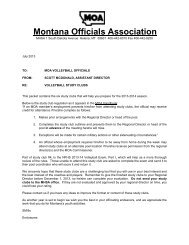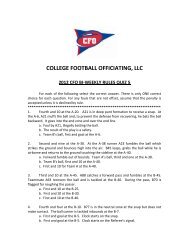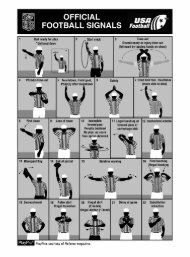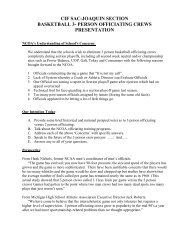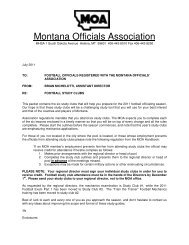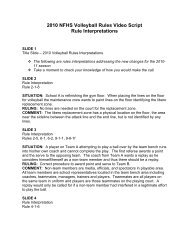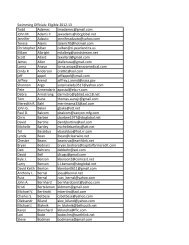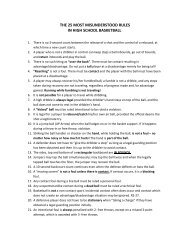2011-12 AND 2012-13 MEN'S AND WOMEN'S RULES - NAIA
2011-12 AND 2012-13 MEN'S AND WOMEN'S RULES - NAIA
2011-12 AND 2012-13 MEN'S AND WOMEN'S RULES - NAIA
Create successful ePaper yourself
Turn your PDF publications into a flip-book with our unique Google optimized e-Paper software.
52<br />
RULE 4 / DEFINITIONS<br />
Art. 4. The referee shall declare a forfeit when a team refuses to play after being<br />
instructed to do so by an official.<br />
Art. 5. The referee shall determine the length of time that shall elapse before a<br />
forfeit may be declared.<br />
Art. 6. Conference policy may include an established time limit before a forfeit<br />
may be declared.<br />
Art. 7. A “no contest” is when a team does not appear at the game site because of<br />
inclement weather, an accident, vehicle breakdown, illness or catastrophic cause.<br />
An institution shall not, for statistical purposes, declare a forfeit for nonfulfillment<br />
of a contract, but rather shall declare a “no contest.” When officials are not<br />
present or available to officiate, there cannot be a sanctioned game/contest.<br />
Section 29. Foul<br />
Art. 1. A foul is an infraction of the rules that is charged to a squad member or a<br />
coach and is penalized in various ways. Following are the types of fouls:<br />
Art. 2. Personal foul. A personal foul shall be a foul committed by a player that<br />
involves illegal contact with an opponent while the ball is live.<br />
a. Common foul. A common foul shall be a personal foul that is neither<br />
flagrant nor committed against a player trying for a field goal, nor part of<br />
a double, multiple or simultaneous foul.<br />
1. Player-control foul. A player-control foul is a common foul committed:<br />
a. (Men) By a player when he is in control of the ball.<br />
b. (Women) By a player when she is in control of the ball or by an<br />
airborne shooter.<br />
2. Team-control foul. A team-control foul is a common foul that is<br />
committed by a member of a team that has team control.<br />
b. Double personal foul. A double personal foul occurs when two opponents<br />
commit personal fouls against each other at approximately the same time.<br />
c. Flagrant 1 personal foul. A flagrant 1 personal foul shall be a personal<br />
foul that is deemed excessive in nature and/or unnecessary, but not based<br />
solely on the severity of the act. Examples include, but are not limited to:<br />
1. Causing excessive contact with an opponent while playing the ball;<br />
2. Contact that is not a legitimate attempt to play the ball or player,<br />
specifically designed to stop or keep the clock from starting;<br />
3. Pushing or holding a player from behind to prevent a score;<br />
4. Fouling a player clearly away from the ball who is not directly<br />
involved with the play, specifically designed to stop or keep the clock<br />
from starting; and<br />
5. Contact with a player making a throw-in. (Women) This act shall also<br />
serve as a team warning for reaching through the boundary. (See Rule<br />
4-17.1.g.)<br />
6. Illegal contact with an elbow that occurs above the shoulders of an<br />
opponent when the elbows are not swung excessively per 4-36.7.a.


